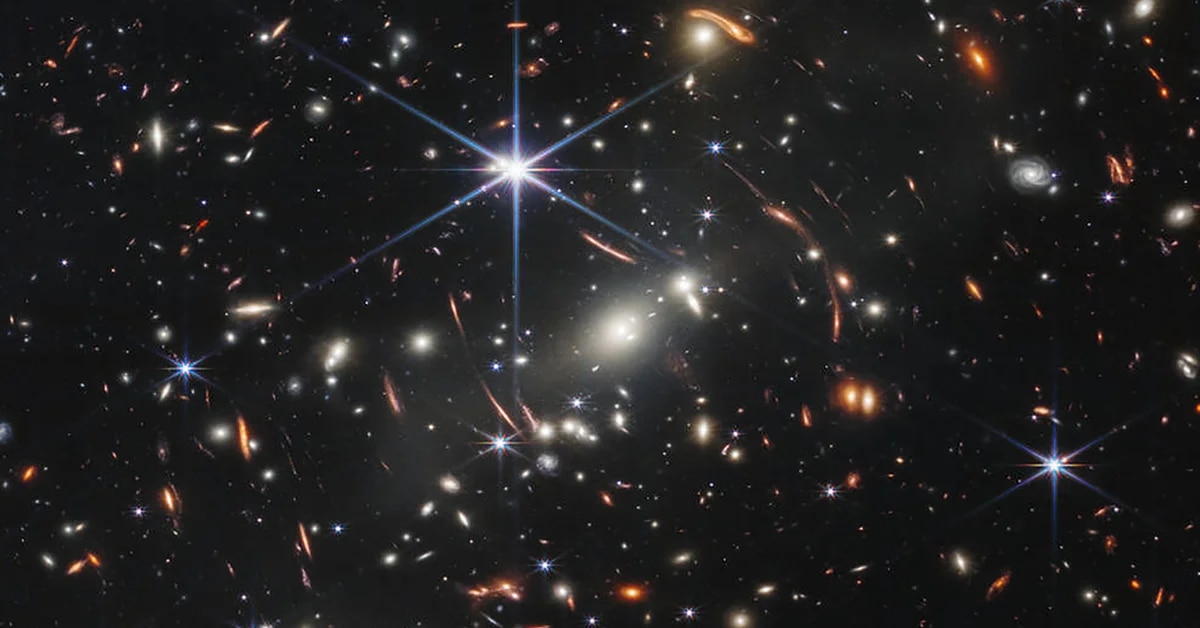Since providing the first image In the highest quality of the universeIn July this year, the The James Webb Space Telescope He never stopped showing photos that amazed scientists. Now, a group of experts known collectively Jades (JWST Advanced Deep Extragalactic Survey – JWST Avanzado Extragalactico Profundo, in Spanish), Galaxies The oldest ever recorded. Although peer validation is still pending, the data the researchers report leaves no room for doubt.
Although they are now complementary in observing the universe, there is still a “race” between the Hubble Space Telescope and its new counterpart, the Webb, to identify which are the oldest galaxies. While the veteran discovered through observations a galaxy dating back 400 million years to the universe, his new rival began to show that his path was just beginning and identified a similar group 330 million years after the Big Bang.
“The light from these galaxies took more than 13.4 billion years to reach us because they arrived 400 million years later. big bangWhen the universe was only 2% of its current age”, experts highlighted a A report by NASA. In this sense, indicated Center of UnityIt was “the birth of everything we know and see and yet, in a cosmic sense, the light emitted from distant galaxies at a time in recent history.”
:quality(85)/cloudfront-us-east-1.images.arcpublishing.com/infobae/EI4V6R3HRVEOPCFPU2AQ36P2UE.jpg 992w)
In this sense, co-author Emma Curtis-Lake, an astronomer from the University of Hertfordshire in the United Kingdom, in a conversation with the North American Space Agency, said, “It is very important to prove that these galaxies actually lived in the early universe. It is possible that very close galaxies became very distant galaxies.” “When we see the spectrum unfolding as we expected, it confirms that these galaxies are at the edge of our view, just a little further away than Hubble can see! This is a hugely exciting achievement for this mission,” he added.
“For the first time, we have discovered Galaxies 350 million years after the Big Bangand we can be absolutely certain of their fantastic distances,” said co-author Brandt Robertson of the University of California, Santa Cruz, a member of NIRCam. “Finding these first galaxies in such stunningly beautiful images is a special experience,” he added.
As indicated by NASA, these “observations are the result of a collaboration between scientists who led the development of two instruments on board, a near-infrared camera (NIRCam) and the near-infrared spectrum (NIRSpec)”. As they pointed out, the study of faint and early galaxies was the main motivation behind the concepts of these instruments, which in 2015 inspired the birth of JADES, “an ambitious project” without precedent to view the early universe, in depth and detail.
:quality(85)/cloudfront-us-east-1.images.arcpublishing.com/infobae/YPWUVRODKBG7VOQK7JEAQUAEKE.webp 420w,https://www.infobae.com/new-resizer/AvAqbxCgrW8-mxAGKoCSxOsg1fg=/768x432/filters:format(webp):quality(85)/cloudfront-us-east-1.images.arcpublishing.com/infobae/YPWUVRODKBG7VOQK7JEAQUAEKE.webp 768w,https://www.infobae.com/new-resizer/HXNIYYLLgtVQ8z6E-S58qzdPlT4=/992x558/filters:format(webp):quality(85)/cloudfront-us-east-1.images.arcpublishing.com/infobae/YPWUVRODKBG7VOQK7JEAQUAEKE.webp 992w,https://www.infobae.com/new-resizer/QZyD6zWlVLTbS-bEeVAx-hEXIVY=/1200x675/filters:format(webp):quality(85)/cloudfront-us-east-1.images.arcpublishing.com/infobae/YPWUVRODKBG7VOQK7JEAQUAEKE.webp 1200w,https://www.infobae.com/new-resizer/TYpWeDxd1uymLGBKJXlRwvt13y0=/1440x810/filters:format(webp):quality(85)/cloudfront-us-east-1.images.arcpublishing.com/infobae/YPWUVRODKBG7VOQK7JEAQUAEKE.webp 1440w)
“These results are the culmination of why the NIRCam and NIRSpec teams came together to run this observational project,” shared NIRCam Principal Investigator Marcia Raik of the University of Arizona in Tucson, noting that JADES is an international team. With more than eighty astronomers from ten countries.
The North American Space Agency, in this sense, “JADES first round of observations focused in and around the Hubble Space Telescope’s deepest field of view”, which for more than two decades “has been almost the objective. All large telescopes produce an exceptionally sensitive data set across the entire electromagnetic spectrum.”
In this way and thanks to these images, experts can distinguish the galaxies of the early universe by the characteristic that they exhibit colors of many wavelengths. In all, four were studied for their special characteristics, “revealing that they existed at an unprecedented early age.”
:quality(85)/cloudfront-us-east-1.images.arcpublishing.com/infobae/QGK3DO66VJGJZPLXXW6S5DJ3CM.png 420w,https://www.infobae.com/new-resizer/otl0QtwvSXkZDdkBn2mY2aipgZE=/768x1365/filters:format(webp):quality(85)/cloudfront-us-east-1.images.arcpublishing.com/infobae/QGK3DO66VJGJZPLXXW6S5DJ3CM.png 768w,https://www.infobae.com/new-resizer/b9q1qbnXqOhG-ecgZ0A6KYJtFcg=/992x1764/filters:format(webp):quality(85)/cloudfront-us-east-1.images.arcpublishing.com/infobae/QGK3DO66VJGJZPLXXW6S5DJ3CM.png 992w,https://www.infobae.com/new-resizer/4D4A5OC89ZSkMV9__hS6ZFaly6U=/1200x2133/filters:format(webp):quality(85)/cloudfront-us-east-1.images.arcpublishing.com/infobae/QGK3DO66VJGJZPLXXW6S5DJ3CM.png 1200w)
“The spectroscopic confirmation results showed that these four galaxies exist at redshifts greater than 10, including two at redshift 13. This corresponds to the age of the Universe. 330 million years“Establishing a new frontier in the search for distant galaxies,” the experts celebrated in a statement released by the North American Space Agency.
But there’s more, they point out, because “these galaxies are very faint due to the great distance separating them from us.” “The wavelength of light is stretched as the universe expands, and the light of these younger galaxies has been stretched up to 14 times,” they said from NASA and pointed out that “astronomers are looking for fainter galaxies in the infrared.” But its light is cut off abruptly at a critical wavelength”, meaning that “the cut-off point within each galaxy’s spectrum is displaced by the expansion of the Universe”.
Astronomer and co-author of the paper, Stefano Carniani, member of the Scuola Normale Superiore in Italy, points out that “these are the faintest infrared spectra ever taken”, adding that “they reveal what we expected to see: a precise measure of the cut-off wavelength of light due to the scattering of intergalactic hydrogen.”
Co-author Sandro Tacchella, an astronomer at the University of Cambridge in the United Kingdom, said, “It is difficult to understand galaxies without understanding the early stages of their development. As with humans, what happens next depends on the impact of these first-generation stars. Many questions about galaxies await the web’s transformative opportunity, and we are thrilled to be able to participate in unfolding this story.”
Despite these revealing data, experts caution that the moniker “spectroscopically confirmed oldest” won’t last long because (in addition to their peers’ agreement) scientists expect to be surprised by older galaxies, as “the web is designed to identify light 100 million years after the Big Bang.” .” According to Robertson, “with these measurements, we can know the intrinsic brightness of galaxies and calculate how many stars they contain,” which is why “they can now begin to study how galaxies form.”
Continue reading:





